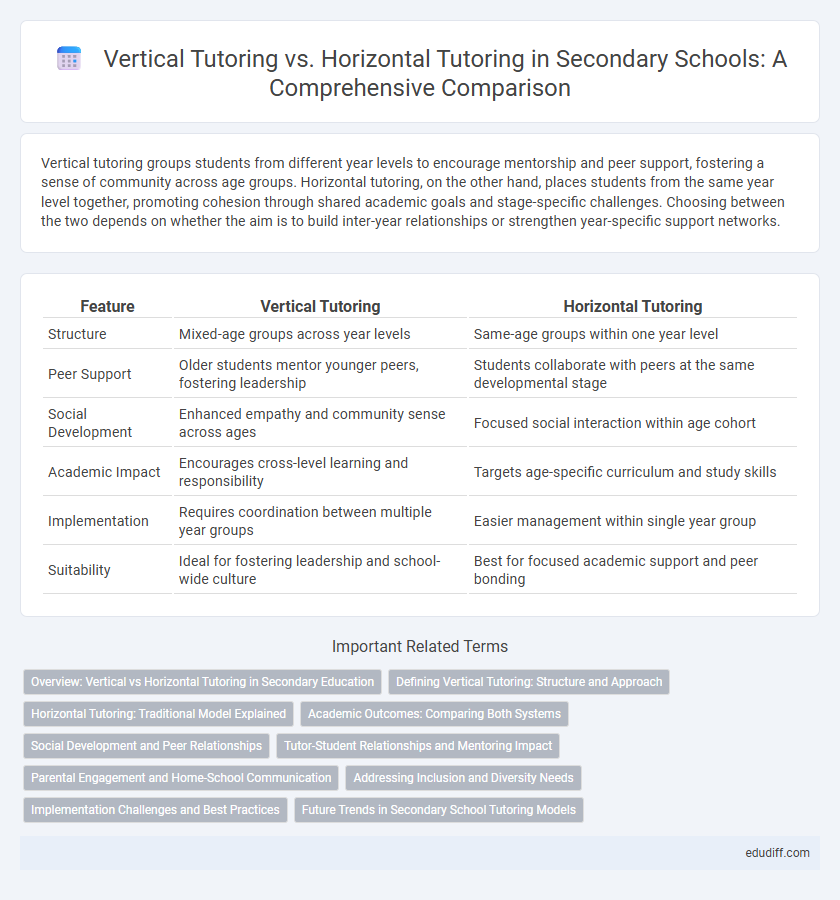Vertical tutoring groups students from different year levels to encourage mentorship and peer support, fostering a sense of community across age groups. Horizontal tutoring, on the other hand, places students from the same year level together, promoting cohesion through shared academic goals and stage-specific challenges. Choosing between the two depends on whether the aim is to build inter-year relationships or strengthen year-specific support networks.
Table of Comparison
| Feature | Vertical Tutoring | Horizontal Tutoring |
|---|---|---|
| Structure | Mixed-age groups across year levels | Same-age groups within one year level |
| Peer Support | Older students mentor younger peers, fostering leadership | Students collaborate with peers at the same developmental stage |
| Social Development | Enhanced empathy and community sense across ages | Focused social interaction within age cohort |
| Academic Impact | Encourages cross-level learning and responsibility | Targets age-specific curriculum and study skills |
| Implementation | Requires coordination between multiple year groups | Easier management within single year group |
| Suitability | Ideal for fostering leadership and school-wide culture | Best for focused academic support and peer bonding |
Overview: Vertical vs Horizontal Tutoring in Secondary Education
Vertical tutoring in secondary education groups students from different year levels into mixed-age tutor groups, fostering peer mentoring, leadership, and a stronger sense of community. Horizontal tutoring organizes students within the same year group, emphasizing age-specific academic support and social cohesion among peers facing similar curriculum challenges. The choice between vertical and horizontal tutoring impacts student engagement, pastoral care quality, and overall school culture development.
Defining Vertical Tutoring: Structure and Approach
Vertical tutoring structures student groups across different year levels, fostering mentorship and peer support by mixing ages to enhance collaborative learning. This approach builds a sustained community where older students guide younger ones, promoting leadership skills and continuity throughout secondary education. The model contrasts with horizontal tutoring, which groups students solely within the same year, limiting inter-age interaction and long-term relational development.
Horizontal Tutoring: Traditional Model Explained
Horizontal tutoring in secondary education refers to a traditional model where students of the same age group and grade level are taught together, fostering a curriculum aligned to their specific academic progress. This approach emphasizes peer interaction within a uniform learning stage, promoting age-appropriate social and cognitive development. Horizontal tutoring ensures targeted instruction that meets the collective educational standards and milestones of a single cohort.
Academic Outcomes: Comparing Both Systems
Vertical tutoring structures foster academic growth by encouraging peer mentoring between different age groups, resulting in improved knowledge retention and critical thinking skills. Horizontal tutoring, with same-age group sessions, focuses on collaborative learning and immediate curriculum needs, enhancing subject-specific understanding and exam performance. Studies show vertical tutoring promotes holistic academic development, while horizontal tutoring optimizes targeted academic achievement in secondary education settings.
Social Development and Peer Relationships
Vertical tutoring enhances social development by fostering mentorship and stronger peer relationships among students of different ages, promoting empathy and leadership skills. Horizontal tutoring focuses on collaboration and shared learning experiences within the same age group, encouraging teamwork and mutual support. Studies show vertical tutoring leads to increased emotional support and community feeling, while horizontal tutoring strengthens academic cooperation.
Tutor-Student Relationships and Mentoring Impact
Vertical tutoring fosters strong tutor-student relationships by pairing students with older peers or mentors, enhancing personalized support and role modeling. Horizontal tutoring involves peers within the same age or grade, promoting collaboration but often lacking the depth of mentorship found in vertical systems. The mentoring impact of vertical tutoring significantly improves student motivation and social-emotional development compared to the more academic-focused approach of horizontal tutoring.
Parental Engagement and Home-School Communication
Vertical tutoring fosters stronger parental engagement by creating multi-age groups that encourage consistent communication between home and school, enhancing parents' understanding of their child's academic progress over time. Horizontal tutoring, while focused on same-age peer groups, often limits sustained parental interaction to a single academic year, reducing opportunities for long-term involvement. Effective home-school communication in vertical tutoring leads to a collaborative environment where parents participate actively in their child's educational journey across different stages.
Addressing Inclusion and Diversity Needs
Vertical tutoring enhances inclusion and diversity by grouping students from different year levels, promoting peer learning, and fostering empathy across age groups. This structure supports varied perspectives and individual needs, creating a more inclusive environment compared to horizontal tutoring, which groups students by the same age and may limit diversity exposure. Vertical tutoring encourages mentorship and social integration, critical for addressing diverse learning requirements and cultural backgrounds effectively.
Implementation Challenges and Best Practices
Vertical tutoring in secondary schools often faces implementation challenges such as mismatched age group dynamics and varied curriculum pacing, requiring tailored communication strategies and flexible scheduling. Horizontal tutoring demands consistent content alignment across same-age groups, with best practices including collaborative teacher planning and continuous student feedback to maintain engagement and relevance. Both approaches benefit from clear goal setting, structured training for mentors, and ongoing monitoring to address the unique social and academic needs of students effectively.
Future Trends in Secondary School Tutoring Models
Future trends in secondary school tutoring models emphasize a shift towards vertical tutoring, which fosters mentorship and peer support across different academic years, enhancing social cohesion and personalized learning. Vertical tutoring supports the development of leadership skills and emotional intelligence among senior students while providing tailored guidance to younger pupils. Emerging technologies are expected to integrate with these models, promoting collaborative digital platforms that adapt to diverse learning needs across year groups.
Vertical Tutoring vs Horizontal Tutoring Infographic

 edudiff.com
edudiff.com